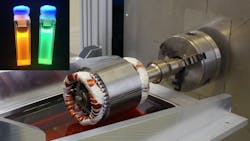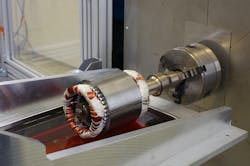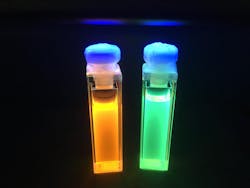Color-Changing Dye Sensors Detect Electric Motor Condition
Scientists have developed a dye process that helps detect wear-and-tear on electric motor wire insulation.
Typically, engineers can tell the condition of an electric motor by the wear on the insulation coating of its copper wires. Inside, they are usually made up of tightly wound copper wires—and these in turn are coated with an insulating resin. When the cable insulation becomes brittle due to heat and chemical processes, it may be an indicator that the motor is nearing end of life.
The trouble is that it’s not possible to tell whether the insulation inside the motor’s housing is still intact without removing the motor’s outer housing.
Scientists at Martin Luther University Halle-Wittenberg (MLU), in collaboration with ELANTAS— a division of the specialty chemicals group ALTANA— attempted to address this problem by developing an integrated dye process that allow them to detect wear on an electric motor’s cable insulation.
“Until now, developers have focused on the degree to which material degrades under specific conditions,” explained Alexander Funtan, a chemist at MLU.
The next step was to develop a method for evaluating how much time would elapse before a replacement is needed. The actual wear, noted the researchers, depends on the conditions (such as temperature) under which a motor is used.
Funtan said he developed a test rig to analyze four different resin systems over several months to determine which degradation products form at different temperatures. He discovered that the four resin systems consistently released a specific alcohol under the different temperature conditions.
“We then worked closely with the researchers and developers at ELANTAS to find a sensor molecule for this alcohol,” he said.
The sensor molecule had to meet the following criteria:
- The sensor molecule had to be a substance that could be easily detectable and whose properties change when the alcohol binds to it.
- The sensor molecule needed to withstand high temperatures and normal production processes.
- The sensor molecule could not change the insulation’s electrochemical properties.
The researchers chose a dye that normally glows reddish orange under UV light; but when alcohol binds to it, the colour spectrum shifts to a light green. The different color spectra, they explained, could then be analyzed using special devices that could be installed directly in the engine.
“This way, you can see if a replacement is necessary without having to open up the engine,” said Professor Wolfgang Binder from the Institute of Chemistry at MLU.
The researchers are hopeful the new insulation will in future mitigate unnecessary motor replacements. Potential uses for the invention include the motors of electric vehicles, as well as machines and other equipment.
ELANTAS filed a patent for the new process at the beginning of the year. The research was financed by the specialty chemicals group ALTANA and also funded by the EU’s BAT4EVER project as part of the “Horizon 2020” programme.
Check out the study: Funtan, A. et al. Self-Diagnostic Polymers – Inline Detection of Thermal Degradation of Unsaturated Poly(ester imide)s. Advanced Materials (2021). doi:10.1002/adma.202100068
About the Author

Rehana Begg
Editor-in-Chief, Machine Design
As Machine Design’s content lead, Rehana Begg is tasked with elevating the voice of the design and multi-disciplinary engineer in the face of digital transformation and engineering innovation. Begg has more than 24 years of editorial experience and has spent the past decade in the trenches of industrial manufacturing, focusing on new technologies, manufacturing innovation and business. Her B2B career has taken her from corporate boardrooms to plant floors and underground mining stopes, covering everything from automation & IIoT, robotics, mechanical design and additive manufacturing to plant operations, maintenance, reliability and continuous improvement. Begg holds an MBA, a Master of Journalism degree, and a BA (Hons.) in Political Science. She is committed to lifelong learning and feeds her passion for innovation in publishing, transparent science and clear communication by attending relevant conferences and seminars/workshops.
Follow Rehana Begg via the following social media handles:
X: @rehanabegg
LinkedIn: @rehanabegg and @MachineDesign


